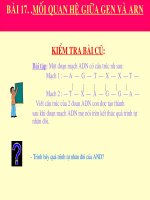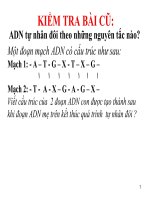Mối quan hệ giữa kiểm soát lạm phát và tăng trưởng kinh tế trong điều hành chính sách tiền tệ ở việt nam tt tiếng anh
Bạn đang xem bản rút gọn của tài liệu. Xem và tải ngay bản đầy đủ của tài liệu tại đây (701.24 KB, 42 trang )
THE STATE BANK OF VIET NAM
MINISTRY OF EDUCATION AND TRAINING
BANKING UNIVERSITY HO CHI MINH CITY
------------------O---------------
NGUYEN THI THU TRANG
RELATIONSHIP BETWEEN INFLATION
AND ECONOMIC GROWTH IN OPERATION
MONETARY POLICY IN VIETNAM
SUMMARY ECONOMIC THESIS
Ho Chi Minh city, 2019
THE STATE BANK OF VIET NAM
MINISTRY OF EDUCATION AND TRAINING
BANKING UNIVERSITY HO CHI MINH CITY
------------------O---------------
NGUYEN THI THU TRANG
RELATIONSHIP BETWEEN INFLATION
AND ECONOMIC GROWTH IN OPERATION
MONETARY POLICY IN VIETNAM
SUMMARY ECONOMIC THESIS
Major: Economics - Finance, Banking
Code: 9.31.12.01
Science guide: Assoc.Prof.Dr. Ha Quang Dao
Ho Chi Minh city, 2019
INTRODUCTION
1- NEED AND SIGNIFICANCE OF THE RESEARCH TOPIC
Economic growth and inflation are two major problems for any economy. In
economic development, the most difficult challenge is the harmonious combination
between economic growth and inflation control. Therefore, one of the important goals of
the managers and regulators of the economy in any country in the world including Vietnam
is to create a stable macroeconomic environment with growth. High and sustainable
economy, together with low inflation.
Inflation is not a strange problem, especially for the commodity economy. In terms
of inflation, over the past two decades, inflation and especially the determinants of inflation
and the fluctuations of inflation have been one of the most discussed topics in Vietnam.
Inflation is a complex issue and depends on many macroeconomic factors. Therefore, the
study of the causes and the search for measures to cope with inflation are always attractive
to the world economists and an annual work of the governments of countries.
Economic growth is even more important and urgent for the least developed
countries, because this is the only way for these countries to close the gap and catch up
with developed countries. Steady and steady economic growth is an important task of a
country, especially developing countries. The high-growth economy allows the country to
fulfill basic tasks such as ensuring sustainable socio-economic development, raising
people's living standards, increasing national security and affirming Positioning of the
country in international relations. This explains why economic growth is always a central
issue in the economic policies and development strategies of every country.
Both inflation and economic growth recently, the instability of the world economy
after the global economic crisis impacted the growth rate and increased inflation in many
countries. including Vietnam. In many countries, achieving high growth rates has to trade
with high inflation. Does Vietnam need to trade like that? To answer that question, it is
necessary to study in depth the interaction between growth and inflation in monetary policy
management, thereby finding a way to achieve the dual goal of curbing inflation.
development and growth, from which the Vietnamese economy meets the conditions for
sustainable development.
Among many factors affecting the relationship between inflation and economic
growth, it is necessary to find out which factors have the strongest impact to get the
implementation measures to solve the double problem: curb inflation and promote growth.
Especially in the context of limited national resources, our problem is how to combine
those resources with weights to achieve optimal efficiency. The interaction between
economic growth and inflation is complex, not always following economic rules. At each
stage of the economy with different levels of economic growth, there will be appropriate
inflation levels. Therefore, the issue of the relationship between economic growth and
inflation is really attractive, especially in the context of economic integration today, then
it is necessary to study such relationship.
That is why I chose the topic "The relationship between inflation and economic
growth in managing monetary policy in Viet Nam" as a research topic.
2- RESEARCH OBJECTIVES
2.1. Overall objectives:
Analyze and assess the situation and factors affecting the relationship between
inflation control and economic concentration in monetary policy management in Vietnam
from 2004 to 2018; From there, propose solutions to impact on this relationship in order to
implement monetary policy management to achieve the dual goal: to control inflation and
increase economic growth. To accomplish the above objective, the following specific
objectives need to be implemented.
2.2. Detail goal:
- Systematically selectively theorize about monetary policy, inflation, economic
growth and the relationship between inflation control and economic growth in managing
monetary policy;
- Identify factors affecting the relationship of inflation control and economic growth
in operating monetary policy in Vietnam;
- Situation of relationship to control inflation and economic growth in operating
monetary policy in Vietnam in Vietnam;
- Solutions to influence inflation control and economic growth in monetary policy
management in Vietnam.
3- RESEARCH QUESTIONS
To accomplish the above objectives, the study will answer the following questions:
1. What is the relationship to control inflation and economic growth in managing
monetary policy in Vietnam?
2. Does inflation control affect the relationship of inflation control and economic
growth in monetary policy management in Vietnam?
3. What factors affect the relationship of inflation control and economic growth in
monetary policy management in Vietnam?
4. What is the solution that affects the relationship of inflation control and economic
growth in managing monetary policy in Vietnam?
4- METHODOLOGY
To achieve the set objectives for the research topic. The research method used in the
thesis is a combination of qualitative and quantitative methods. In which the qualitative
method is essential. As follows:
Qualitative research methods:
This method is used by collecting secondary data sources such as surveys, books,
newspapers, magazines, and dissertations. thesis, law, summary report of the State Bank,
relevant ministries, General Department of Statistics, ... from which summarize, analyze
and compare.
Quantitative research methods:
Quantitative research by sending surveys to knowledgeable experts in the financial,
monetary and policy sectors. Collect and process data using SPSS software. With this
method, to assess the reliability and suitability of factors affecting the relationship between
inflation control and economic growth in operating monetary policy in Vietnam.
5-
SUBJECTS OF RESEARCH AND SCOPE OF RESEARCH
- Object of research: The author studies issues related to the relationship between
inflation control and economic growth in monetary policy management in Vietnam.
- Scope of research: secondary data of the General Statistics Office, SBV on
monetary policy management, inflation and economic growth in Vietnam in the 2004-2018
period.
6- RELATED RESEARCH WORKS
6.1. Overview of related research
There are many research works: thesis, articles, discussion papers on
monetary policy, inflation, economic growth as well as the relationship between them.
•
The dissertations focused on analyzing the relationship between monetary
policy and macroeconomic policies, post-crisis experiences and solutions to complete
monetary policy can include:
PhD thesis of PhD student. Nguyen Thi Kim Thanh "Improving the monetary
transmission mechanism of the State Bank of Vietnam in the context of international
economic integration" in 2008 of the Hanoi Banking Academy.
PhD thesis of PhD student. Nguyen Thi Van Anh "Researching the impact
of monetary policy on Vietnam's macro economy" in 2018 of the University of Commerce.
PhD thesis of PhD student. Khuat Duy Tuan "Managing monetary policy to
control inflation during the transition of the economy in Vietnam" in 2012 of Hanoi
National Economics University.
•
The dissertation researches on inflation, the relationship between inflation
and economic growth, can include:
PhD thesis of PhD student. Pham Thai Ha "Solution to control inflation in
Vietnam" in 2012 by Hanoi Banking Academy.
PhD thesis of PhD student. Nguyen Thi Phuong Nhung "The relationship
between economic growth and the stock market in Vietnam" in 2012 of University of
Economics - Law, Vietnam National University, Ho Chi Minh City.
Master thesis of Tran Thi Thuy Trang "The relationship between inflation
and economic growth in Vietnam" in March 2016 of the University of Finance and
Marketing.
Master's thesis by Le Thi Dung "Inflation and economic growth in Vietnam"
in December 2012 of Ho Chi Minh City University of Economics.
Quantitative studies often use VAR family models to evaluate the effectiveness of
monetary policy impacts through channels:
Article by MSc. Ha Thi Huong Lan: “Growth and inflation in Vietnam” On July 18,
2012, posted on the website of the financial training fostering section, the research and
exchange section used the Co-linked regression method, Model Error correction (ECM)
and Method of variance analysis (VAR model) analyze consumer price index (CPI) and
gross domestic income (GDP) (data released by the General Statistics Office of Vietnam )
to conclude: "... the relationship between growth and inflation in Vietnam (in the long and
short term) is basically consistent with the theory and test results in the world of Tobin
(1965) ), Mallik and Chowdhury (2001), Frria and Carneiro (2001) have published. It can
be affirmed: the relationship between growth and inflation of the Vietnamese economy
follows the general rule. ”Article by Nguyen Thi Thuy Vinh“ Studying the role of monetary
transmission channels for growth and inflation In April 2015, Vietnam magazine of
Economics and Development.Le and Pfau (2008) developed a VAR model and concluded
that interest rate channel had no significant impact, money supply has a strong impact on
output. Camen (2006) used an original Baysian VAR model to test the effectiveness of
monetary policy. Bhattacharya and Duma (2012) studied monetary policy of Vietnam in
the period of 2004-2012 using SVAR model and showed that interest rates only affect
inflation in a short time; Nguyen Thi Lien Hoa and Dang Tran Dung (2013) also used the
SVAR method and came to the conclusion that exchange rates and interest rates were
weakly affected; M2 has a strong impact with a 6 month lag to inflation. Bui Quoc Dung
(2017) using the VAR model shows that LSCS has had a good effect in curbing inflation
for the period since 2011. Pham Chi Quang (2019) studied the transmission mechanism of
monetary policy in the period of 2006-2016 by using VARs model and VEC variant forms,
Engel-Granger regression model.
6.2. Limitations and research gaps
The review showed that the previous studies still had certain limitations, namely: (i)
There were no studies on monetary policy, inflation and economic growth in the period
2004-2018; (ii) Most of the in-depth studies assessing the relationship on inflation and
economic growth in Vietnam have not evaluated the factors affecting the relationship
between them, in order to find the root cause thoroughly resolving the relationship between
inflation and economic growth; (iii) Most of the in-depth studies assess the relationship of
inflation and economic growth in Vietnam but are not associated with operating monetary
policy.
From the above limitations, it shows that the research gap needs to be considered,
that is, there should be a separate study on the theory and practice of the relationship
between inflation and economic growth in the administration of monetary policy in the
period from 2004-2018; At the same time, research on other countries' experiences and
lessons related to solving this relationship. Since then, in-depth analysis to identify the
factors affecting the relationship between inflation and economic growth ... in order to
achieve the maximum goals of monetary policy: to control inflation and promote economic
growth. International. The solution from the root causes factors affecting the relationship
between inflation and economic growth in Vietnam.
7- NEW POINTS OF THE THESIS
Firstly, the thesis systematizes the theory of inflation, economic growth and
monetary policy. Especially using the model to show the relationship between inflation and
economic growth in operating monetary policy in Vietnam.
Secondly, the overall relationship between inflation control and economic growth
promotion in monetary policy management from theory to practice in Vietnam is assessed.
Thirdly, find out the factors affecting the relationship between inflation and
economic growth in Vietnam
Fourthly, the thesis studies how the government can achieve the dual goal of
controlling inflation and promoting economic growth in operating monetary policy based
on scientific research.
8- THESIS STRUCTURE
In addition to the introduction and conclusion, the structure thesis consists of 4
chapters
Chapter 1: Monetary policy, the relationship between inflation and economic
growth in managing monetary policy.
Chapter 2: Models and methods of studying the factors affecting the relationship
between inflation and economic growth
Chapter 3: Current situation of relationship between controlling inflation and
promoting economic growth in managing monetary policy in Vietnam.
Chapter 4: Addressing the relationship between controlling inflation and promoting
economic growth in managing monetary policy in Vietnam.
1
CHAPTER 1: MONETARY POLICY AND RELATIONSHIP BETWEEN INFLATION AND ECONOMIC GROWTH
1.1. Overview of monetary policy
1.1.1. Concepts and characteristics of monetary policy
1.1.1.1. Concept
In short, monetary policy is the sum of the ways in which the central bank through its activities affects the amount of money
in circulation to serve the country's socio-economic goals. in a given period. It is an important part of the government's macroeconomic policy system.
Chart 1.1: Definition of monetary policy
Policy
Monetary policy
economic purpose
Monetary
Article 2 of the State Bank of Vietnam law states: “The national monetary policy is a part of the State's economicfinancial policy to stabilize the value of money, curb inflation and contribute to promoting socio-economic development,
ensuring national defense and security and improving the people's life ".
2
1.1.1.2. Monetary policy characteristics
• Monetary policy is an integral part of national financial policy
• Monetary policy is a macroeconomic tool
• The central bank is the agency that sets and operates monetary policy
• The overall objective of monetary policy is to stabilize the value of money and contribute to the implementation of
a number of other macroeconomic goals.
1.1.2. Target operating monetary policy
1.1.2.1. The ultimate goal of monetary policy
The ultimate goal of monetary policy in many countries in the world is to stabilize monetary value, thereby contributing to
the promotion of high economic growth and employment.
In addition to the above macro goals, some countries also focus on addressing specific goals, depending on their
specific economic development characteristics.
Relationship between goals:
Thus, in the short term, the central bank cannot achieve all of the above goals. Most central banks consider price
stability to be the main and long-term goal of monetary policy, but in the short term sometimes they have to temporarily
abandon the main objective to overcome the sudden high unemployment or the Effect of supply shocks on output. The Central
Bank is considered to have the power to do this because it has the tools to regulate the amount of money provided. It can be
said that the Central Bank pursues one goal in the long term and multiple goals in the short term.
3
1.1.2.2. Intermediate target
Intermediate targets include targets selected by the Central Bank to achieve the ultimate goal of monetary policy. The
targets often used as intermediate targets are the total amount of money supply (M1, M2, or M3) or market interest rates (short
and long-term interest rates).
In addition to the above two goals, there are a number of other indicators that are candidates for intermediate target role
such as total credit volume, exchange rate.
1.1.2.3.
Operation target
These indicators have immediate reaction to the adjustment of monetary policy tools.
1.1.3. Monetary policy management tools
• Open market operations.
Open operation is a transaction in which the State Bank “performs open market operations through short-term buying
and selling of treasury bills, certificates of deposit, SBV bills and other valuable papers in the market. currency to implement
NTP ”
• Reserve requirement.
Compulsory reserve is the amount of money that a CI must deposit at the SBV to implement the National Monetary
Policy. The State Bank of Vietnam stipulates the required reserve ratio for each type of credit institution and each type of
deposit with the rate from 0% to 20% of the total deposit balance at each CI in each period.
• Exchange rate tool
The exchange rate is the ratio between the value of Vietnamese dong and the value of foreign currencies. In terms of
economic openness, foreign economic activities with flows of goods and capital entering and exiting a country have a great
influence on the national macroeconomic indicators. To implement the National Monetary Policy, the State Bank of Vietnam
4
shall base on the supply and demand of foreign currencies in the market and the State's regulatory needs to determine and
announce the exchange rate of Vietnam dong.
• Credit limit is the maximum debt level that the SBV requires credit institutions to comply with when granting credit
to the economy. The level of outstanding loans is determined for each bank based on the business characteristics of each
bank (customer structure, risk level), overall economic structure orientation, the need to sponsor policy beneficiaries. and it
must be within the limits of the estimated total outstanding credit of the entire economy over a given period.
• Interest rate framework
The interest rate range will have a direct effect on market interest rates, including the ceiling rate (the maximum
interest rate that banks are allowed to set when borrowing or lending) and interest. floor rate (the minimum interest rate that
banks are allowed to set when lending or borrowing.
• Rediscount tool
The rediscount policy includes provisions on lending to credit institutions (CIs). The SBV often lends to credit
institutions in the form of discounting short-term valuable papers (mainly treasury bills and commercial bills) brought by
credit institutions, therefore, the SBV's lending policy to credit institutions is called rediscount policy.
1.2. Inflation and economic growth
1.2.1. Overview of inflation
1.2.1.1. Concept and measurement
According to the author, inflation can be conceptualized as follows: "Inflation is a rise over time of the general price level of
the economy, thus reducing the value of money."
Currently, many countries around the world are using the consumer price index as a measure of inflation. However, this
indicator is still not ideal because it does not meet the above standards. Many imported goods are still included in the CPI. On the
5
other hand, this index can only measure the fluctuation of retail prices of some goods and services, not the total consumer
spending, which is not comprehensive. In addition, this index covers important food items and all prices of goods sensitive to
changes in tax policy; ie affected by temporary price increases that have been excluded from the above definition of inflation.
Finally, the consumer price index does not reflect the improvement of the quality of goods and services after a relatively long
period of time.
1.2.1.2.
Different views on inflation
The cost theory argues that inflation arises because the increase in production and business costs is faster than the increase
in labor productivity.
Structural theory is common in many developing countries. According to this theory, inflation arises because of a profound
imbalance in the structure of the economy, including the imbalance between accumulation and consumption, between heavy
industry and light industry, between industry and agriculture. between manufacturing and services ...
The static conception of inflation is that inflation is an imbalance between money and goods in the economy.
The theory of demand was initiated by the English economist John Maynard Keynes. He said that the underlying cause of
inflation is fluctuations in supply and demand.
The concept of inflation is most commonly used in the past 3 decades by the school of money. In this view, inflation is a
persistent movement in the direction of increasing of the common price level of the economy.
1.2.1.3. The causes leading to inflation
1.2.1.3.1. Classical School of Economics (Classical School)
The theory of money was born three centuries ago but until now it has always been controversial and has not ended among
macroeconomists.
1.2.1.3.2. Demand drag inflation
6
John Maynard Keynes (1883-1946), the British economist and his school economists, argued that inflation was not caused
by monetary factors but rather by aggregate demand. at full employment.
1.2.1.3.3. Cost push inflation
The theory of cost push inflation is based on the fact that some producers are likely to raise prices of products, unions
representing workers who are likely to demand an increase in wages (the value of labor services). (dynamic) higher than its real
price in a competitive market.
1.2.1.4. Factors affecting inflation
1.2.1.4.1. Gross domestic product.
GDP is an important general economic indicator, reflecting the entire end result of production activities of all permanent
units in a country's economy in a given period; reflect the relationships in the process of production, income distribution and final
use of products and services in the national economy; is a proxy for economic growth.
1.2.1.4.2. Money supply
Classical and neoclassical economists have used the money economist theory of the US economist Irving Fisher to explain
the causes of monetary inflation as follows:
MV = PT
1.2.1.4.3. Exchange rate
The exchange rate is the rate at which one currency will be exchanged for another. It is also considered to be the value of
one country's currency against another currency.
7
1.2.1.4.4. Interest rate
Theoretically, nominal interest rates and inflation have a positive relationship.
1.2.1.4.5. World oil prices
Petroleum is a commodity that has a very high indirect impact on the volatility of the CPI, many other items will be affected
when the price of gasoline fluctuates, because gasoline is a factor reflecting the input costs of many products. other in the basket of
goods for calculation of CPI
1.2.2. Overview of economic growth
1.2.2.1. Concept of economic growth
Economic growth is an increase in the income of an economy over a period of time. The increase is manifested in scale and
speed. The increase in scale of growth reflects the increase more or less, which means an increase in the absolute amount.
1.2.2.2. Factors affecting economic growth
* Human Resources
*Natural resources
*Capital
*Technology
1.2.2.3. The theory of economic growth
1.2.2.3.1. Growth model of the classical school (David Ricardo Model)
- The theory of "Labor value": he thinks that labor is the basic source of creating all wealth for the country.
- The "Invisible Hands" doctrine: if he is not controlled by the government, workers will be motivated by profits to produce
the necessary goods and services and through this free market personalities will be associated with social benefits.
1.2.2.3.2. Growth model of neoclassical school (Cobb - Douglas model)
8
Contents of the model
Following the neoclassical model, there are factors affecting growth: labor (L), capital (K), natural resources (R), and
science - technology (T). Thus the production function is:
Y = f (K, L, R, T)
1.2.2.3.3. Growth model of the Keynesian school (growth model of Harrob - Domar)
1.2.2.3.3.1. Assumptions of the Harrob - Domar growth model
- Fixed technology. The production function has no T.
- The law of diminishing marginal profits does not dominate production.
- Total investment = total savings = total capital increase
Contents of the model
Production function: Y = f (L, K, R)
Solow's growth model
Production function: Y = f (K, L, R, T). According to this model, how savings, population growth and technological
progress affect production as well as economic growth. A notable feature of the model is that Solow has put his calculations
on the per capita number, this ensures a more rational, fairer growth and simplifies the calculation. Solow also explains the
gaps of the economies, the convergence properties of the economy - or the rich-poor gap between nations with a leapfrog
theory.
1.2.2.3.3.2. Modern growth model of Samuelson
Modern economic growth theory is consistent with the definition of neoclassical economic model of resource
factors, K, L, R, T and raising R into a natural resource rather than just land. as before. And agree on the type of analysis of
the Cobb - Douglas function on the impact of resource factors.
9
Samuelson calls these elements the source of growth. However, he put R in K and called T as TEF: production
efficiency. The labor factor L is not merely manual labor, but education is important for a qualified labor force that
influences production efficiency and contributes to TEF.
In short, we can say that modern economic theory has solved the problems, overcome the shortcomings of previous
economic models, and moreover, it has systematically and accurately evaluated sufficient and clear the role of resource
factors and the relationship between them.
1.2.2.3.3.3. Measure economic growth
Performed by math, there will be a formula:
y = dY / Y × 100 (%)
Scientific arguments about the relationship between inflation and economic growth in operating monetary policy
1.2.3.1.
The theory of the relationship between inflation and economic growth
1.2.3.2.
The theory of the relationship between inflation and economic growth
According to the Keynesian theory
In money-importantism (represented by Milton Fredman
According to the neoclassical theory Mundell (1965) and Tobin (1965)
Based on Keynesian theory, several economic views hold that moderate inflation will drive growth (Mubarik, 2005).
Meanwhile, some research and empirical evidence shows that inflation can have a negative impact on economic growth when it
exceeds a certain threshold (Ocran 2007; Khan and Senhadji, 2001). Even if inflation is zero or deflation will have a negative
effect on economic growth.
1.2.3.3.
Experimental studies on the relationship between inflation and growth
10
From the views of scientists and from the experience of advanced countries, through evaluation studies, practical reviews,
the author finds that:
If using the co-linked regression method, the adjusted errors model (ECM) and the variance analysis method (VAR model)
analyze consumer price index (CPI) and gross domestic income (GDP) ) (data published by the General Statistics Office of
Vietnam), according to the following formula:
M.V = P.Y (Fisher's equation); where: M is the money supply; V is the coefficient of money creation; P is the price; Y is the
output (GDP)
1.3. Experience of some countries in solving the relationship between inflation and economic growth in managing
monetary policy and lessons for Vietnam
1.3.1. Experience of some countries in dealing with the relationship between inflation and economic growth in
managing monetary policy
1.3.1.1. Experience of China
1.3.1.2. Japanese experience
1.3.1.3. Experience of India
1.3.2. Lessons learned for Vietnam
A review of current cross-national international evidence, as well as evidence from Asia, shows a negative relationship
between inflation and long-term growth. Countries with low or moderate levels of inflation have higher long-term growth than
countries with high inflation rates. However, low inflation is not a sufficient condition for growth. India's experience seems to
support this view.
11
CONCLUSION OF CHAPTER 1
In chapter 1 of the thesis, the author systematizes the theory of a number of basic issues:
Firstly, systematizing theories about monetary policy, including the contents: concepts, characteristics, goals, tools of
monetary policy (clearly speaking about the concept, operating mechanism, advantages and disadvantages of each work).
instrument).
Secondly, systematizing the theory of inflation, including the following contents: concepts (according to different schools),
methods of measuring inflation, and causes of inflation.
Third, systematize the theory of economic growth, which deals with the following contents: concepts, factors affecting
economic growth, macro issues related to economic growth, method of measuring economic growth.
Fourth, present scientific arguments about the relationship between inflation and economic growth.
Fifthly, theoretical presentation of econometric models examines the relationship between inflation and economic growth.
Fifthly, present lessons learned in monetary policy management in some countries: China, Japan, India, from which to draw
lessons for Vietnam.
12
CHAPTER 2: MODEL AND METHOD OF RESEARCHING FACTORS AFFECTING RELATIONSHIP BETWEEN
INFLATION AND ECONOMIC GROWTH
This chapter presents research models and methods and methods of processing and analyzing data to build and evaluate the
scales in the model and put hypotheses.
2.1. Research models
2.1.1 The proposed research model
Refer to the research related to the topic and consult experts, the research model factors affecting the relationship between
development and economic growth include 6 influencing factors and 1 secondary variable. of:
(1) Monetary Policy Element;
(2) Factors of inflation;
(3) Human resource factor;
(4) Capital factor;
(5) Technology factors;
(6) Natural resources factor.
2.3. Quantitative research
Quantitative research to check the scales in the research model through the questionnaire survey.
2.3.1 Data processing method
Descriptive statistics
Test the reliability of the scale by Cronbach’s Alpha
Test the scale by exploratory factor analysis of EFA
13
Model testing by linear regression
2.3.2. Research data
2.3.2.1 Secondary data
Secondary data includes results of studies related to the topic; statistics, reports on activities of inflation, economic growth
and socio-economic situation in the period of 2004-2018 of Vietnam; Secondary data is collected through books, magazines,
domestic and foreign research works; Statistical yearbooks, reports of the General Statistics Office, concerned ministries and
branches, ...
2.3.2.2 Primary data
Primary data was collected through printed printed questionnaire.
2.3.3 Sample design
To achieve the research objectives of the topic, the author chooses a non-probability sampling method with sample size 356.
This is a method that is less expensive in time and cost of collecting research information.
Characteristics of research sample: Education; Agency work; Working position; Working time.
2.3.4 Data analysis techniques
Use SPSS 20.0 and Microsoft Excel 2007 software used for data processing and analysis. For the convenience of data entry,
analysis and presentation, research variables are pre-coded. The data analysis process is done through the following steps:
2.3.4.1 Test the scale using Cronbach’s alpha reliability coefficient
2.3.4.2 Exploratory Factor Analysis (EFA)
2.3.4.3 Multivariate linear regression analysis (Multiple Regression Analysis (MRA)
2.4. The results of analysis of factors affecting the relationship between inflation and economic growth
14
The results of the research were conducted according to the following steps, including: descriptive statistics of survey
sample information, verification of reliability of the scale through Cronbach’s alpha coefficient and total variable correlation
coefficient; EFA discovery factor analysis; building a modified research model by linear regression analysis, and testing
hypotheses of the model.
2.4.1 Characteristics of research sample
Table 2.2: Survey sample characteristics
Criteria
1 Level
Number of
observations
356
Perce
ntage%
100
1 University
87
24,6
2 Master
197
55,4
3 Doctor, professor
72
20,0
2 Agency of work
356
100
1 Research Institute
44
12,2
2 Divisions, agencies and businesses
114
32,0
3 University
130
36,5
4 Bank
32
9,0
5 Finance
36
10,3
3 Job title
356
100
1 Leadership, equivalent
41
11,5
2 Manager, equivalent
101
28,3
15
3 Senior specialist
84
23,7
4 Expert
130
36,5
4 Working time
356
100
1 Less than 5 years
53
14,7
2 From 5 - 10 years
141
39,7
3 From 10 - 15 years
105
29,5
4 Over 15 years
57
16,1
Source: Author synthesis
2.4.2 Testing the scale
Testing scale with Cronbach's Alpha coefficient
Table 2.3: Assessment of reliability of component scales
Factor
CSTT
CSTT1
CSTT2
CSTT3
CSTT4
CSTT5
LP
LP1
LP2
Averag
Variable
Total
Cronbach’s
e
scale
if s if variable variable
Alpha coefficient if
variable type
type
correlation
if variable type
variable type
Cronbach Alpha: .873
13.74
13.76
13.71
13.66
13.78
6.92
6.83
14.043
.677
13.567
.717
13.613
.720
13.993
.664
13.245
.720
Cronbach Alpha: .821
3.683
3.829
.659
.680
.851
.841
.841
.854
.841
.769
.750
16
LP3
NL
6.79
3.526
.688
Cronbach Alpha: .884
.740
NL1
NL2
NL3
NL4
NL5
NL6
VDT
17.10
17.13
16.96
17.09
17.06
17.13
20.887
.698
21.525
.626
20.984
.688
20.792
.688
20.576
.723
20.102
.749
Cronbach Alpha: .825
.863
.875
.865
.865
.859
.855
VDT1
VDT2
VDT3
CN
7.01
7.08
7.07
4.253
.655
4.016
.680
3.831
.710
Cronbach Alpha: .825
.784
.760
.729
10.40
10.26
10.39
10.35
6.326
.670
7.584
.734
6.617
.617
6.303
.642
Cronbach Alpha: .837
.772
.767
.796
.787
CN1
CN2
CN3
CN4
TN
TN1
TN2
TN3
MQH
MQH1
MQH2
MQH3
6.88
3.811
6.79
4.199
6.93
3.736
Cronbach Alpha: .919
6.42
6.42
6.42
2.035
2.036
2.036
.713
.670
.714
.758
.801
.758
.843
.833
.833
.878
.887
.887
Soure: SPSS 20









